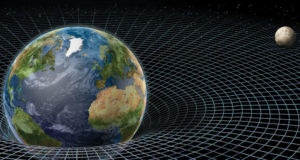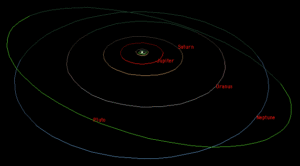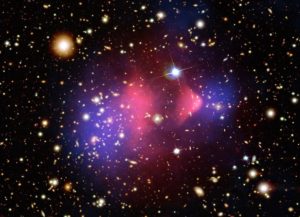Perhaps nothing provokes as much derision and scoffing from the new geocentrists as the scientific discussion about dark matter. Geocentrists take this discussion as a prime example of their contention that many physicists are basically frauds, duping an unsuspecting public by simply making up whatever details they happen to need to prop up theories which they know in their hearts are really in shambles.
But in reality the geocentric derisive treatment of the theory of dark matter provides an excellent illustration of the extent to which the new geocentrists themselves turn the process of true scientific endeavor on its head. It further illustrates the extent to which geocentrism itself is utterly unscientific. The double standards held by the new geocentrists come boldly into relief when illuminated by the discussion on dark matter. Let’s see how.
Starting With What You Know Best
True scientific exploration starts with what we can observe most closely and measure most accurately. It then builds on that to help us understand what we don’t yet know. In the case of astronomical exploration, this means using knowledge gleaned from the interactions of the bodies within our own solar system to help us understand the interactions of bodies on much larger scales, such as stellar clusters, galaxies, and galactic clusters.
Hundreds of years of observations and measurements by countless scientists have led to the conclusion that massive bodies attract other massive bodies in direct proportion to their mass. We call this attractive force gravity. Some geocentrists are quick to declare that we don’t know yet exactly how or why gravity works. Those are great and intriguing questions, but completely beside the point. Not knowing exactly how something works should not be used as an excuse to dismiss the fact that it does work. All of the observations that we can make most clearly and the measurements that we can make most accurately show that massive bodies attract other massive bodies in proportion to their mass, according to well-defined and well-understood physical laws. So well established is this phenomenon that even geocentrist Rick DeLano states that “To deny gravity is to deny reason itself.” I agree.
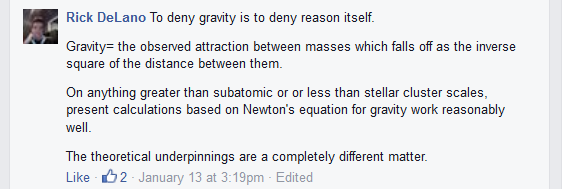 We also observe that all over the universe, less massive bodies are captured by the stronger gravitational field of more massive bodies and end up orbiting.[1] Planets and asteroids orbit stars, moons orbit around planets, and there are even asteroids that have tiny little asteroid moonlets orbiting around them (link).
We also observe that all over the universe, less massive bodies are captured by the stronger gravitational field of more massive bodies and end up orbiting.[1] Planets and asteroids orbit stars, moons orbit around planets, and there are even asteroids that have tiny little asteroid moonlets orbiting around them (link).
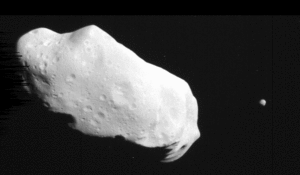 So precise, so unvarying are these laws in our own solar system that scientists and engineers can calculate the future position of a given planet, moon, or even comet and send space probes to explore them. In 2014 we witnessed the incredible feat of the Rosetta probe landing on comet 67P/Churyumov-Gerasimenko after having travelled four billion miles in the course of ten years. And recently we also witnessed another probe rendezvous with Pluto after having done a gravitational slingshot maneuver off Jupiter, using that massive planet’s rotation to boost the probe on its way to Pluto in its almost three billion mile journey.
So precise, so unvarying are these laws in our own solar system that scientists and engineers can calculate the future position of a given planet, moon, or even comet and send space probes to explore them. In 2014 we witnessed the incredible feat of the Rosetta probe landing on comet 67P/Churyumov-Gerasimenko after having travelled four billion miles in the course of ten years. And recently we also witnessed another probe rendezvous with Pluto after having done a gravitational slingshot maneuver off Jupiter, using that massive planet’s rotation to boost the probe on its way to Pluto in its almost three billion mile journey.
I agree with geocentrist Dr. Neville Jones that given the suppositions of the geocentrists on the nature of the universe, such feats of celestial navigation would be impossible – certainly the geocentrists themselves could never pull them off – and therefore the only alternative is that they’re all faked: “These conclusions would mean that claims made by the American government agency, NASA, regarding space probes, gravity slingshots, comet rendezvous and so on, would be fraudulent . . .” (link) and “I maintain that a Biblical, non-moving World cannot be maintained if it turns out that NASA put men on the Moon” (link).
Searching for Answers
But when scientists observe much larger cosmic bodies they find something puzzling. Galaxies, for example, rotate faster than would be expected given the mass of the visible objects that we observe in them. Why would this be? One possible explanation is that there is some additional mass in these galaxies, some form of mass that we cannot yet see. This has been dubbed “dark matter”, because it cannot yet be directly observed.
Here’s where the hooting starts from the geocentric gallery – haw, haw, making it up as you go along, eh? But is this really an unreasonable surmise, given what we can observe most closely and measure most accurately? Let’s look at a concrete example to see why it’s not.
Enter the Dark Planet
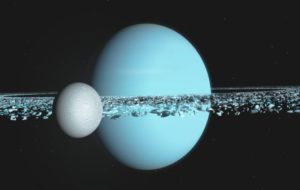 Some of the planets in our solar system, like Venus and Mars, can be viewed with the naked eye. Others, like Uranus, can only be observed via telescope. As astronomers used powerful telescopes to chart the motions of Uranus more and more accurately, they found small deviations in that planet’s orbit, “irregularities in its path which could not be entirely explained by Newton’s law of gravitation.” (Wikipedia, “Uranus”).
Some of the planets in our solar system, like Venus and Mars, can be viewed with the naked eye. Others, like Uranus, can only be observed via telescope. As astronomers used powerful telescopes to chart the motions of Uranus more and more accurately, they found small deviations in that planet’s orbit, “irregularities in its path which could not be entirely explained by Newton’s law of gravitation.” (Wikipedia, “Uranus”).
Even though they could not see it, there was indirect evidence that “something” else was there.
One can just imagine the analogs of the geocentrists in that day, scoffing at a “dark planet” theory and dismissing it outright. One could easily imagine them jumping immediately to the conclusion that the existing laws of gravitation were all wrong and needed to be scrapped, as “proved” by the perturbations in Uranus’s orbit.
But instead, it was perfectly reasonable to suppose that, given the laws of physics that we can establish most clearly and accurately, it was more likely that “something” was there than that the laws themselves were completely wrong. And so scientists applied those now well-established laws of gravitation and, based on the nature of the perturbations they observed, calculated where the unseen object should be. And indeed something was there. On September 24, 1846 the planet Neptune was finally observed “after less than an hour of searching and less than 1 degree from the position Le Verrier had predicted, a remarkable match” (link) Since then hundreds of astronomical objects – including planets around other stars than our own (see “Exoplanets”) – have been discovered based on the effects that “dark” objects (that is, objects that can’t yet be seen) have on nearby visible objects.
While dark matter cannot be directly observed at this time, there are several ways the influence of “something else” shows up indirectly. It’s not just the rotation rate of galaxies, but also such phenomena as gravitational lensing and the power spectrum of the cosmic microwave background (CMB) (see here). For some details and very nice graphics, see Dr. Ethan Siegel’s “Five Reasons We Think Dark Matter Exists” and “Convincing a Young Scientist That Dark Matter Exists”.
Still, it could be that there is another, better explanation for all of these observations. In fact, there have been many alternative theories of gravity itself proposed to explain them. These are not suppressed or hooted down out of hand. They are evaluated, analyzed, debated. But currently, the majority of astrophysicists agree that some sort of matter that is not yet detectable best explains all of the observations. If some other theory comes along that explains all of the observable data better than some form of dark matter, eventually that view will win the day.
All this to say, though, that there is nothing fundamentally foolish or unreasonable about hypothesizing that something like dark matter exists. It’s currently the best explanation for astronomical anomalies on a large scale, given what we know from what we can observe most closely and measure most accurately – how gravity behaves on smaller scales.[2] But there are many other proposals being discussed and evaluated – if one of those theories ends up explaining all of the observational evidence better, then it will eventually carry the day.
Geocentrism: Flipping Science on Its Head
Here is where the new geocentrism proves itself to be utterly unscientific. In fact, it flips the entire scientific method on its head. Focusing back on our own solar system we observe that the distance from the sun and period of revolution of Mercury, Venus, Mars, Jupiter, Saturn, Uranus, Neptune, Pluto, and a host of asteroids and comets are just exactly what the universal law of gravitation predicts, given their mass and the mass of the sun. We know, then, that these bodies are orbiting the sun or, to be more precise, that they are mutually orbiting a common barycenter that is very, very near the center of the sun.
What about the Earth? Lo and behold, the Earth happens to be at just the distance and have just mass and period that we would expect if it was orbiting the sun according to this same law. What a strange coincidence, huh? The simple, reasonable conclusion that the Earth orbits the sun and rotates on its axis, just like any other planet, is all that is needed to explain this “coincidence”, along with a host of observations – from the seasons to stellar parallax to nutation to stellar aberration to the equatorial bulge, etc. Nothing more is needed to explain all of these observations – just the Earth orbiting its star and revolving on its axis according to the normal laws of physics, just like any other planet. (On the other hand, for geocentrism to be viable the geocentrists would have to provide observational evidence for both the existence of and precise motion of masses that at every instant of time are positioned perfectly to offset the enormous gravity of the Sun and other planets, thus leaving the Earth motionless. There is no such observational evidence. Therefore, geocentrism is not a viable scientific theory. See “It Really Is That Simple: Geocentrism Lacks Basic Evidence”).
But because the geocentrists have started with a fixed conclusion, they are not free to embrace this simple, reasonable explanation, no matter how much evidence accrues in its favor. So they must invent “explanations” as to how things can “really” be geocentric, in spite of the laws of nature which we can observe most closely and measure most accurately.
Let’s look at a concrete example.
Sungenis’s “Planck Medium”: Explaining Nothing and Supported by No One
In late 2014 we documented how Robert Sungenis made basic math errors when trying to explain why the sun – which he claims orbits the Earth, but could not possibly be held in place by the Earth’s gravity – does not shoot off into space. He twice tried to calculate the enormous centrifugal force that would need to be overcome to keep the sun in such an orbit and got the calculation wrong both times (see “Elementary Physics Blunders” and “Sungenis Botches the Math….Again!”). But the bottom line is that he acknowledged that the centrifugal force of the rotating sun would be vastly greater than the gravitational attraction of the Earth. In his geocentric universe, something else besides gravity would have to be holding the sun in place. What might that be? He gives this answer:
So how does the geocentrist explain the extra 12 orders of magnitude? He does so by saying that the centrifugal force is not on the Sun, but on the Planck medium that constitutes the space that carries the Sun (something Newtonian mechanics never considered but which Quantum Mechanics says exists).
Since Planck particles have dimensions of 10^33cm, 10^5grams, and an overall density of 3.6 x 10^93 grams/cm^3, the Planck medium absorbs the tremendous centrifugal forces of a rotating universe, and the celestial bodies (the stars and galaxies) will be kept in tow by the rotating universe (“Response to Sky and Telescope Re: The Principle”).
In a follow-up article Sungenis as much as admitted that it doesn’t really matter what force is calculated – his “Planck medium” will handle it no matter what:
Note well: MacAndrew’s previous argument against geocentrism, which stated that the gravitational force of the sun would pull in the Earth, is completely nullified, whether the centrifugal units are 10e6 and 10e11 or 10e28 and 10e33 (“David Palm’s Academy Award Winning Performance of Straining a Gnat and Swallowing a Camel”, pp. 2f.)
So basically Sungenis only attempted the calculation in order to appear competent (while demonstrating the opposite.) Because in the end we find that, unlike in real science, in geocentric “science” the actual answer doesn’t matter. In Sungenis’s system a mythical “Planck medium” will absorb whatever forces he needs it to absorb, while remaining completely undetectable when he has no use for it. And this isn’t science, it’s magic. As Dr. MacAndrew rightly says,
The geocentrists have invented an entity, which they call the “Planck medium”, and Sungenis claims that it “absorbs” the centrifugal force. Needless to say, he doesn’t describe the physical properties of this medium which allow it to “absorb” the centrifugal forces. Does it do so gravitationally, by viscous drag, by electrostatics or magnetics? Who can say? How can it “absorb” these stupendous dynamic forces, and yet be completely undetectable? Only Bob knows (“Elementary Physics Blunders”).
Remember the discussion above about the motions of the planets, how Neptune’s position was accurately predicted using only Newton’s laws of gravitation? Funny, isn’t it, how none of those scientists had to factor into their calculations the existence of this “Planck medium”, that absorbs gigantic centrifugal forces without breaking a sweat? Hold that thought.
Here’s another thing to consider. Dr. MacAndrew notes that reality stubbornly refuses to go along with Sungenis, because the vacuum simply doesn’t have the properties he attributes to it:
when geocentrists like Sungenis talk about the “Planck medium”, which is a term used almost exclusively by geocentrists, they are probably referring to the hypothesised vacuum energy or zero point energy of the vacuum that arises from a naïve interpretation of Quantum Field Theory. A naïve calculation results in an infinite energy density for the vacuum, and a slightly less naïve calculation yields a finite but stupendously large value. Since the energy of the vacuum is measured to be actually rather small . . . it is clear that there must be a problem in the renormalisation step of the QFT calculation at these scales. . . . in any case, it is empirically clear that the vacuum doesn’t have the viscous or drag properties that Sungenis wants it to have. Even if the zero point energy is what he means when he speaks of the “Planck medium”, he has imbued it with properties that it doesn’t have, even as a highly hypothetical entity in QFT (“Elementary Physics Blunders”).
There is no observational evidence – none, not even indirect – for Sungenis’s “Planck medium”. And yet his system cannot possibly work without it. Isn’t this the very thing that Sungenis is constantly harping on—scientific theories that don’t match up with experimental reality? MacAndrew sums up well, “You can explain anything at all, to your own satisfaction, if you make it up as you go along,” and points out the obvious:
No-one else performing real, complicated celestial mechanics calculations (like NASA or ESA for example!) has to invoke this fantasy. This made-up medium, this fairy dust has no physical interaction other than magically doing just what he needs it to do while remaining completely undetectable whenever he doesn’t need it – way to go, Bob (“Elementary Physics Blunders”).
To which Sungenis had no cogent reply at all, but merely this dodge:
Apparently, MacAndrew is not up to speed on the literature regarding the Planck medium that I cited above. As for who is inventing a “fantasy,” the Dark Matter and Dark Energy of Alec in Wonderland’s Big Bang theory wins the prize (“Alec in Wonderland Meets the Queen of Planckdom”, p. 45).
Apparently what NASA really needs is some scientists and engineers who are up to speed on the literature regarding the “Planck medium,” so that they can finally launch successful space missions? Oh, wait…..the real engineers and scientists who do real-world work like sending space probes to land on comets and slingshot off of Jupiter to rendezvous with Pluto do all of their work as if Sungenis’s “Planck medium” doesn’t exist.
The most obvious reason for that is that it doesn’t exist.
Geocentrism: Why Bother?
 So here’s the bottom line. There is a fundamental difference in modern scientific discussions about dark matter, versus the neo-geocentric invocation of something like a “Planck medium”.
So here’s the bottom line. There is a fundamental difference in modern scientific discussions about dark matter, versus the neo-geocentric invocation of something like a “Planck medium”.
On the one hand, scientists start with what they know best, can observe most clearly, and measure most accurately – objects at the scale of our own solar system – and from these observations derive physical laws. At these most observable scales, these laws work out to many, many decimal points. They then apply these physical laws to seek the best explanation to certain anomalies in observations at much larger scales. A large consensus of working physicists hold that some form of dark matter is the best explanation for these anomalies and a number of converging lines of observational evidence leads them to this conclusion.
On the other hand, the simple conclusion that the Earth orbits the sun and rotates on its axis, just like any other planet, is all that is needed to explain a host of observations – from stellar parallax to nutation to stellar aberration to the equatorial bulge, etc. There is no need to posit that the entire universe is wiggle-wagging, and shilly-shallying, and rock-n-rolling in just the ways that it would need to mimic the observations we would expect if the Earth was orbiting the sun and rotating on its axis. And Sungenis’s invocation of the “Planck medium” is a solution looking for a problem. It is not involked to uphold and harmonize with already observed universal laws – rather, it’s invoked precisely to prop up an arbitrary exception to those universe laws. As St. Thomas Aquinas says, “If a thing can be done adequately by means of one, it is superfluous to do it by means of several; for we observe that nature does not employ two instruments where one suffices”.
What observations with respect to the Earth’s motion does the mythical “Planck medium” account for that cannot be infinitely more easily explained by simple appeal to gravity? How many working astronomers or physicists believe in the existence of such a “Planck medium” having the specific characteristics Sungenis believes it has? What experiments does Sungenis cite to show that his “Planck medium” has any of these specific characteristics? None, none, and none.
There are good reasons why all working physicists – Christians, Jews, and yes, even atheists – have for centuries rejected strict geocentrism. They rejected it before big bang cosmology came on the scene and they’ll continue to reject it if some other theory replaces it. There isn’t any atheistic, “they know it, but they’re hiding it” conspiracy to suppress geocentrism. Working scientists universally reject geocentrism because there is no observational evidence to support it, whereas on the other hand there is a perfectly simple explanation for why the Earth doesn’t plunge into the Sun – it’s rotating around its star according to the universal law of gravity, like any other planet.
What reason would we have to seek some other explanation? There is no good reason. The fact is that, for all their “science” talk, the geocentrists do not hold to geocentrism because it is the most obvious and plausible scientific solution. It’s not reasonable at all – rather, it’s a massive exercise in special pleading, gummed together with conspiracy theories.
Geocentrists hold to geocentrism first and fundamentally as a matter of faith—they believe that their faith compels them to do so. And then, because they (mistakenly) believe it is a matter of faith, they are willing to do all manner of backflips and turn science completely on its head to make geocentrism look scientifically plausible.
Ironically the gaping double standards of the new geocentrists are indeed illuminated most clearly by dark matter.
End Notes:
[1] Technically, of course, these objects orbit a common barycenter. But when one of the objects is considerably more massive than the other, as in the case of a planet orbiting a star or a moon orbiting a planet, that barycenter lies so near the center of the star that it is convenient shorthand to say that the planet orbits the star and the moon orbits the planet.
[2] At the very least, alternative theories to dark matter are openly debated in technical journals and a physicist who succeeded in unseating dark matter as the best explanation for the various anomalies would stand, in the end, to gain a fair bit of notoriety. On that note, it might be worth anticipating a cynical geocentrist reply that one possible reason that scientists cling to the dark matter theory is that they have a large financial interest in maintaining funding for the research tools being used to search for it. Scientists are human, of course, and could succumb to less than lofty motives in holding onto a particular theory. But the same can be said of the geocentrists. Let’s be frank – geocentrists Robert Sungenis and Rick DeLano, at least, make their entire livelihood peddling geocentrism. As such it’s hard to imagine that they are going to be extremely open to a change of mind that would entail not only the public admission of error, but the loss of their income as well.

